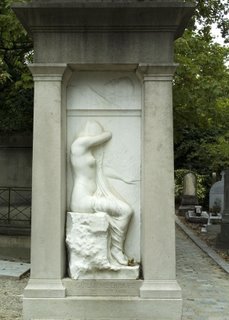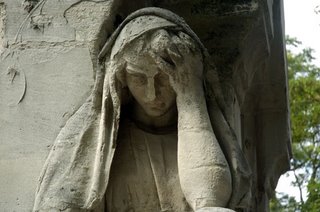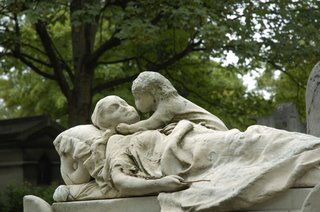 Montparnasse was originally called the “southern cemetery” of Paris, and is divided by rue Emile Richard, which effectively cuts it into two sections.
Montparnasse was originally called the “southern cemetery” of Paris, and is divided by rue Emile Richard, which effectively cuts it into two sections.This division is described by Culbertson/Randall as “old” and “new” sections, with the “old” section being the smaller of the two, whereas Bertrand Beyern's Guide des Tombes d'hommes celebres, refers to the "old" section as the "petit" or small cemetery. For our purposes we'll stick with Culbertson/Randall.) In effect divisions 17, 19, and 25-27 all have both “new” and “old” parts. A quick glance at the map provided by the cemetery office will show you how this works. (photo: grave of Alain Leseiutre in division 1.)
And speaking of maps, the only one available is that provided by the cemetery. If you are looking for someone not on the map and inquire at the office you will need to know a date of death as well as the name.
At half the size of Pere Lachhaise and laid out in a much more orderly fashion, Montparnasse feels and indeed looks like a typical cemetery. Streets are laid out at (mostly) right angles, and divisions appear easily marked. At first glance you might think it will be a breeze finding your way around. Looks can be deceiving, however, and Montparnasse is no exception.
 The singular problem at Montparnasse is that the lines separating the divisions are often faint if not impossible to discern. Divisions 10-13 and 9-6 run very close together, with a thin, virtually nonexistent line separating one from the other. You will have to spend some time acquainting yourself with the layout and how one section connects with one another in order to use the maps effectively – and particularly if you are looking for several or more individuals. I continued using the Culbertson/Randall book (1986 edition) and found their maps to be a bit more helpful since they at least tried to lay out the smaller alleyways which sort of subdivided divisions. (photo: grave of Cesar Baldichinni in division 6.)
The singular problem at Montparnasse is that the lines separating the divisions are often faint if not impossible to discern. Divisions 10-13 and 9-6 run very close together, with a thin, virtually nonexistent line separating one from the other. You will have to spend some time acquainting yourself with the layout and how one section connects with one another in order to use the maps effectively – and particularly if you are looking for several or more individuals. I continued using the Culbertson/Randall book (1986 edition) and found their maps to be a bit more helpful since they at least tried to lay out the smaller alleyways which sort of subdivided divisions. (photo: grave of Cesar Baldichinni in division 6.)Montparnasse is the resting place for several individuals whose fame transcends French borders. Cesar Franck, Camille Saint-Saens, the American actress Jean Seberg, French photographer Man Ray, Irish playwright Samuel Beckett, Statue of Liberty designer Frederic Bartholdi, flutist Jean-Pierre Rampal, writer Charles Baudelaire and philosopher Jean-Paul Sartre.
Others worthy of a stop for their fantastic sculptures marking: aviatrice Maryse Bastie (division 6), Cesar (Baldicchini in division 3), Honore Champion (division 3), Antoine Etex (division 7), de Max’s "separation of a couple” (division 4), Henri Laurens (also division 7), Charles Sainte-Beuve (division 17), and Baudelaire’s cenotaph between division 26 and 27 (new cemetery).
 Probably the most controversial gravesite in Montparnasse – if not in all of Paris – is that of former French army office Alfred Dreyfus. Tried for treason on trumped up charges the case became a cause celebre marking the highpoint (or rather low point) in corrupt French politics framed by Emile Zola’s famous ‘J’accuse” directed at the very cornerstone of the rot in the system, Felix Faure gross army incompetence and latent anti-Semitism, all issues which would continue to plague France until well into the 20th century and beyond. Curiously Alfred’s grave cannot be presently located or at least the headstone seems to be missing. (Oh and if you're wondering, Felix Faure is buried in Pere Lachaise, laid out just as he was when he died in his mistress's bed). (photo: de Max's "separation of a couple" in division 4.)
Probably the most controversial gravesite in Montparnasse – if not in all of Paris – is that of former French army office Alfred Dreyfus. Tried for treason on trumped up charges the case became a cause celebre marking the highpoint (or rather low point) in corrupt French politics framed by Emile Zola’s famous ‘J’accuse” directed at the very cornerstone of the rot in the system, Felix Faure gross army incompetence and latent anti-Semitism, all issues which would continue to plague France until well into the 20th century and beyond. Curiously Alfred’s grave cannot be presently located or at least the headstone seems to be missing. (Oh and if you're wondering, Felix Faure is buried in Pere Lachaise, laid out just as he was when he died in his mistress's bed). (photo: de Max's "separation of a couple" in division 4.)Less well known and not marked in the Culbertson/Randall book but still worth a look are:
- an angel holding a young woman over the grave of Alain Lesieutre (division 1)
- pair of enormous hands holding a cross at Robert Thibier’s grave (division 2)
- a woman forever dropping flowers onto a grave (division 3)
- Charles Blech’s grave with a woman seated wearing a veil (division 4)
- Laurent Simonpaoli’s bold sculpture (division 6)
- “Ricardo’s” big toy (division 6)
- the chessboard over world chess champion Alexander Alekhine (division 8)
- Pierre Felix de Morant’s bust and his death mask on the same stone (division 9)
- the touching Milik monument (division 10)
- Rene and Marcelle Combe’s monument to each other (division 10)
- Valentine Lecomte du Nuoy reclining for eternity (divison 13)
- statuette holding the stone down over the De Dieu Anglade family (division 13)
- the woman holding the wall back over the Bartlett family (division 12/13)
- the disturbing piece over Leopold Kretz (division 14)
- the enormous insect holding forth in division 18 (right along Avenue de l’Est)
- Rene Marchand’s insouciant monument which is
- next to Charles Pigeon reading (?) to his wife in bed (division 22)
- the diminutive angel mourning for Albert Coet (division 22)
- Jenny Mewes and her family (division 26 new)
- a uniformed Nicolai Roussev striding and carrying a bugle (division 26 old)
- the Morice family (division 26 old)
- Nancy Fleury’s name being written forever (division 27 new)
- woman reading to child at the Barboux monument (division 28)
- the mystery of Claude Jauberthie and her signaling quiet (division 28)
- angel with horn at the Touzet family (division 29)
- yet another woman sleeping for eternity (division 29)
- the Wallon family and their awesome mosaics (division 29)
- the poignancy of the Dudzhik & Mimran monument (division 29)
- kissing mama (?) goodbye at the Maillols’ monument (division 29)
- and Armand Cahen’s art deco pavilion (division 30).
I have posted a wide vaariety of photos from Montparnasse online. You can see them by simply clicking here.
If you have any questions, corrections or suggestions about the cemetery by all means send it on. Not even the dead stay put forever.
Next up -- Montmartre cemetery!












